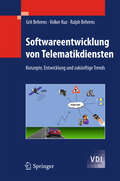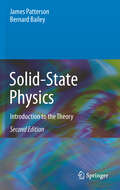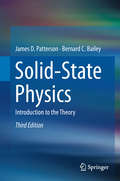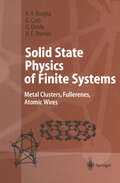- Table View
- List View
Software Test Attacks to Break Mobile and Embedded Devices: Software Test Attacks To Break Mobile And Embedded Devices (Chapman And Hall/crc Innovations In Software Engineering And Software Development Ser. #6)
by Jon Duncan HagarAddress Errors before Users Find ThemUsing a mix-and-match approach, Software Test Attacks to Break Mobile and Embedded Devices presents an attack basis for testing mobile and embedded systems. Designed for testers working in the ever-expanding world of "smart" devices driven by software, the book focuses on attack-based testing that can be used by
Software Test Attacks to Break Mobile and Embedded Devices: Software Test Attacks To Break Mobile And Embedded Devices
by Jon Duncan HagarAddress Errors before Users Find ThemUsing a mix-and-match approach, Software Test Attacks to Break Mobile and Embedded Devices presents an attack basis for testing mobile and embedded systems. Designed for testers working in the ever-expanding world of "smart" devices driven by software, the book focuses on attack-based testing that can be used by
Softwareentwicklung von Telematikdiensten: Konzepte, Entwicklung und zukünftige Trends (VDI-Buch)
by Grit Behrens Volker Kuz Ralph BehrensDas Buch vermittelt einen Einstieg in die Software-Entwicklung von Telematikdiensten mit einem Eclipse-Plugin für das Common Service Framework (Open Source). Ziel ist es, Nutzer dazu zu befähigen, internetbasierte Telematikdienste selbst zu programmieren. Begleitend zum Buch steht ein Internetportal bereit, wo Beispielapplikationen demonstriert, getestet oder weiter entwickelt werden können. Es gibt des Weiteren Einblick in die Hintergründe und die weltweiten Zukunftsentwicklungen auf dem rasant anwachsenden Gebiet der Telematikdienste.
Softwarepraktikum - Analysis und Lineare Algebra: Ein MAPLE-Arbeitsbuch mit vielen Beispielen und Lösungen
by Dorothea Bahns Christoph SchweigertComputeralgebra- Systeme wie MAPLE gehören heute zum Alltag aller, die Mathematik in Schule, Wirtschaft und Hochschule anwenden. Gleichzeitig bieten sie die Möglichkeit, in ganz anderer Weise Beispiele zu untersuchen und zu veranschaulichen, als dies mit Bleistift und Papier möglich ist. Neben einer Einführung in MAPLE hat dieses Buch zum Ziel, durch die Behandlung von Beispielen den Stoff des ersten Studienjahres, wie er in den Vorlesungen zur Analysis und Linearen Algebra behandelt wird, zu vertiefen und zu veranschaulichen. Es besteht aus Aufgaben mit Erläuterungen, anhand derer der Leser den Stoff eigenständig durcharbeiten soll. Mathematische Anwendersysteme als berufsbildende Kompetenz in der Bachelor-Ausbildung: Das Buch eignet sich für ein Modul aufbauend auf den Grundvorlesungen Analysis und Lineare Algebra. Materialien zu diesem Buch für das E-Learning System OKUSON werden für Dozenten unter OnlinePLUS bereitgestellt.
Soil Dynamics and Foundation Modeling: Offshore and Earthquake Engineering (Risk Engineering)
by Junbo JiaThis book presents a comprehensive topical overview on soil dynamics and foundation modeling in offshore and earthquake engineering. The spectrum of topics include, but is not limited to, soil behavior, soil dynamics, earthquake site response analysis, soil liquefactions, as well as the modeling and assessment of shallow and deep foundations. The author provides the reader with both theory and practical applications, and thoroughly links the methodological approaches with engineering applications. The book also contains cutting-edge developments in offshore foundation engineering such as anchor piles, suction piles, pile torsion modeling, soil ageing effects and scour estimation. The target audience primarily comprises research experts and practitioners in the field of offshore engineering, but the book may also be beneficial for graduate students.
Soil Stress-Strain Behavior: A Collection of Papers of the Geotechnical Symposium in Rome, March 16-17, 2006 (Solid Mechanics and Its Applications #146)
by Hoe I. Ling Luigi Callisto Dov Leshchinsky Junichi KosekiThe material in this work is focused on recent developments in research into the stress-strain behavior of geomaterials, with an emphasis on laboratory measurements, soil constitutive modeling and behavior of soil structures (such as reinforced soils, piles and slopes). The latest advancements in the field, such as the rate effect and dynamic behavior of both clay and sand, behavior of modified soils and soil mixtures, and soil liquefaction are addressed.
Sojourns And Extremes of Stochastic Processes
by Simeon BermanSojourns and Extremes of Stochastic Processes is a research monograph in the area of probability theory. During the past thirty years Berman has made many contributions to the theory of the extreme values and sojourn times of the sample functions of broad classes of stochastic processes. These processes arise in theoretical and applied models, and are presented here in a unified exposition.
Sojourns And Extremes of Stochastic Processes
by Simeon BermanSojourns and Extremes of Stochastic Processes is a research monograph in the area of probability theory. During the past thirty years Berman has made many contributions to the theory of the extreme values and sojourn times of the sample functions of broad classes of stochastic processes. These processes arise in theoretical and applied models, and are presented here in a unified exposition.
Sojourns in Probability Theory and Statistical Physics - I: Spin Glasses and Statistical Mechanics, A Festschrift for Charles M. Newman (Springer Proceedings in Mathematics & Statistics #298)
by Vladas SidoraviciusCharles M. (Chuck) Newman has been a leader in Probability Theory and Statistical Physics for nearly half a century. This three-volume set is a celebration of the far-reaching scientific impact of his work. It consists of articles by Chuck’s collaborators and colleagues across a number of the fields to which he has made contributions of fundamental significance. This publication was conceived during a conference in 2016 at NYU Shanghai that coincided with Chuck's 70th birthday.The sub-titles of the three volumes are: I. Spin Glasses and Statistical MechanicsII. Brownian Web and PercolationIII. Interacting Particle Systems and Random Walks The articles in these volumes, which cover a wide spectrum of topics, will be especially useful for graduate students and researchers who seek initiation and inspiration in Probability Theory and Statistical Physics.
Sojourns in Probability Theory and Statistical Physics - II: Brownian Web and Percolation, A Festschrift for Charles M. Newman (Springer Proceedings in Mathematics & Statistics #299)
by Vladas SidoraviciusCharles M. (Chuck) Newman has been a leader in Probability Theory and Statistical Physics for nearly half a century. This three-volume set is a celebration of the far-reaching scientific impact of his work. It consists of articles by Chuck’s collaborators and colleagues across a number of the fields to which he has made contributions of fundamental significance. This publication was conceived during a conference in 2016 at NYU Shanghai that coincided with Chuck's 70th birthday.The sub-titles of the three volumes are:I. Spin Glasses and Statistical MechanicsII. Brownian Web and PercolationIII. Interacting Particle Systems and Random WalksThe articles in these volumes, which cover a wide spectrum of topics, will be especially useful for graduate students and researchers who seek initiation and inspiration in Probability Theory and Statistical Physics.
Sojourns in Probability Theory and Statistical Physics - III: Interacting Particle Systems and Random Walks, A Festschrift for Charles M. Newman (Springer Proceedings in Mathematics & Statistics #300)
by Vladas SidoraviciusCharles M. (Chuck) Newman has been a leader in Probability Theory and Statistical Physics for nearly half a century. This three-volume set is a celebration of the far-reaching scientific impact of his work. It consists of articles by Chuck’s collaborators and colleagues across a number of the fields to which he has made contributions of fundamental significance. This publication was conceived during a conference in 2016 at NYU Shanghai that coincided with Chuck's 70th birthday.The sub-titles of the three volumes are:I. Spin Glasses and Statistical MechanicsII. Brownian Web and PercolationIII. Interacting Particle Systems and Random WalksThe articles in these volumes, which cover a wide spectrum of topics, will be especially useful for graduate students and researchers who seek initiation and inspiration in Probability Theory and Statistical Physics.
Solar Electromagnetic Radiation Study for Solar Cycle 22: Proceedings of the SOLERS22 Workshop held at the National Solar Observatory, Sacramento Peak, Sunspot, New Mexico, U.S.A., June 17–21, 1996
by Judit M. Pap Claus Öhlich Roger K. UlrichMeasurements of solar irradiance, both bolometric and at various wavelengths, over the last two decades have established conclusively that the solar energy flux varies on a wide range of time scales, from minutes to the 11-year solar cycle. The major question is how the solar variability influences the terrestrial climate. The Solar Electromagnetic Radiation Study for Solar Cycle 22 (SOLERS22) is an international research program operating under the auspices of the Solar-Terrestrial Energy Program (STEP) Working Group 1: `The Sun as a Source of Energy and Disturbances'. STEP is sponsored by the Scientific Committee of Solar-Terrestrial Physics (SCOSTEP) of the International Council of Scientific Unions (ICSU). The main goal of the SOLERS22 1996 Workshop was to bring the international research community together to review the most recent results obtained from observations, theoretical interpretation, empirical and physical models of the variations in the solar energy flux and their possible impact on climate studies. These questions are essential for researchers and graduate students in solar-terrestrial physics.
Solar Magnetic Fields: Polarized Radiation Diagnostics (Astrophysics and Space Science Library #189)
by Jan Olof StenfloMagnetic fields are responsible for much of the variability and structuring in the universe, but only on the Sun can the basic magnetic field related processes be explored in detail. While several excellent textbooks have established a diagnostic foundation for exploring the physics of unmagnetized stellar atmospheres through spectral analysis, no corresponding treatise for magnetized stellar atmospheres has been available. The present monograph fills this gap. The theoretical foundation for the diagnostics of stellar magnetism is developed from first principles in a comprehensive way, both within the frameworks of classical physics and quantum field theory, together with a presentation of the various solar applications. This textbook can serve as an introduction to solar and stellar magnetism for astronomers and physicists at the graduate or advanced undergraduate level and will also become a resource book for more senior scientists with a general interest in cosmic magnetic fields.
Solar Polarization (Astrophysics and Space Science Library #243)
by K. N. Nagendra Jan Olof StenfloNovel instruments for high-precision imaging polarimetry have opened new possibilities, including for exploring effects in radiative scattering, atomic physics, spectral line formation, and radiative transfer. This volume gives a comprehensive and up-to-date account of this rapidly evolving and interdisciplinary field of science.
Solar Polarization: Proceedings of an International Workshop held in St. Petersburg, Russia, 8–12 May, 1995
by Jan Olof Stenflo K. N. NagendraMuch progress has been made in recent years in understanding the complex physics of polarized radiation in the sun and stars. This physics includes vector radiative transfer and spectral line formation in the presence of magnetic fields, scattering theory and coherence effects, partial redistribution and turbulent magnetic fields, numerical techniques and Stokes inversion, as well as concepts for polarimetric imaging with a precision limited only by photon statistics. The present volume gives a comprehensive and up-to-date account of this rapidly evolving field of science.
Solid Geometry with MATLAB Programming (River Publishers Series in Mathematical and Engineering Sciences)
by Nita H. Shah Falguni S. AcharyaSolid geometry is defined as the study of the geometry of three-dimensional solid figures in Euclidean space. There are numerous techniques in solid geometry, mainly analytic geometry and methods using vectors, since they use linear equations and matrix algebra. Solid geometry is quite useful in everyday life, for example, to design different signs and symbols such as octagon shape stop signs, to indicate traffic rules, to design different 3D objects like cubicles in gaming zones, innovative lifts, creative 3D interiors, and to design 3D computer graphics. Studying solid geometry helps students to improve visualization and increase logical thinking and creativity since it is applicable everywhere in day-to-day life. It builds up a foundation for advanced levels of mathematical studies. Numerous competitive exams include solid geometry since its foundation is required to study other branches like civil engineering, mechanical engineering, computer science engineering, architecture, etc. This book is designed especially for students of all levels, and can serve as a fundamental resource for advanced level studies not only in mathematics but also in various fields like engineering, interior design, architecture, etc. It includes theoretical aspects as well as numerous solved examples. The book includes numerical problems and problems of construction as well as practical problems as an application of the respective topic. A special feature of this book is that it includes solved examples using the mathematical tool MATLAB.
Solid Geometry with MATLAB Programming (River Publishers Series in Mathematical and Engineering Sciences)
by Nita H. Shah Falguni S. AcharyaSolid geometry is defined as the study of the geometry of three-dimensional solid figures in Euclidean space. There are numerous techniques in solid geometry, mainly analytic geometry and methods using vectors, since they use linear equations and matrix algebra. Solid geometry is quite useful in everyday life, for example, to design different signs and symbols such as octagon shape stop signs, to indicate traffic rules, to design different 3D objects like cubicles in gaming zones, innovative lifts, creative 3D interiors, and to design 3D computer graphics. Studying solid geometry helps students to improve visualization and increase logical thinking and creativity since it is applicable everywhere in day-to-day life. It builds up a foundation for advanced levels of mathematical studies. Numerous competitive exams include solid geometry since its foundation is required to study other branches like civil engineering, mechanical engineering, computer science engineering, architecture, etc. This book is designed especially for students of all levels, and can serve as a fundamental resource for advanced level studies not only in mathematics but also in various fields like engineering, interior design, architecture, etc. It includes theoretical aspects as well as numerous solved examples. The book includes numerical problems and problems of construction as well as practical problems as an application of the respective topic. A special feature of this book is that it includes solved examples using the mathematical tool MATLAB.
Solid Mechanics: An Introduction (Solid Mechanics and Its Applications #15)
by J.P. WardThis book is intended as an introductory text on Solid Mechanics suitable for engineers, scientists and applied mathematicians. Solid mechanics is treated as a subset of mathematical engineering and courses on this topic which include theoretical, numerical and experimental aspects (as this text does) can be amongst the most interesting and accessible that an undergraduate science student can take. I have concentrated entirely on linear elasticity being, to the beginner, the most amenable and accessible aspect of solid mechanics. It is a subject with a long history, though its development in relatively recent times can be traced back to Hooke (circa 1670). Partly because of its long history solid mechanics has an 'old fashioned' feel to it which is reflected in numerous texts written on the subject. This is particularly so in the classic text by Love (A Treatise on the Mathematical Theory of Elasticity 4th ed., Cambridge, Univ. Press, 1927). Although there is a wealth of information in that text it is not in a form which is easily accessible to the average lecturer let alone the average engineering student. This classic style avoiding the use of vectors or tensors has been mirrored in many other more 'modern' texts.
Solid Modeling and Applications: Rapid Prototyping, CAD and CAE Theory
by Dugan UmThis updated, second edition provides readers with an expanded treatment of the FEM as well as new information on recent trends in rapid prototyping technology. The new edition features more descriptions, exercises, and questions within each chapter. In addition, more in-depth surface theory has been introduced in section four, with particular emphasis in surface theory. Promising cutting edge technologies in the area of rapid prototyping are introduced in section seven, MATLAB-based FEM analysis has been added in section eight, and development of the plan stress and plane strain stiffness equations are introduced as a new chapter. Revised and updated based on student feedback, Solid Modeling and Applications: Rapid Prototyping, CAD and CAE Theory is ideal for university students in various engineering disciplines as well as design engineers involved in product design, analysis, and validation. It equips them with an understanding of the theory and essentials and also with practical skills needed to apply this understanding in real world design and manufacturing settings.
Solid Modeling and Applications: Rapid Prototyping, CAD and CAE Theory
by Dugan UmThe lessons in this fundamental text equip students with the theory of Computer Assisted Design (CAD), Computer Assisted Engineering (CAE), the essentials of Rapid Prototyping, as well as practical skills needed to apply this understanding in real world design and manufacturing settings. The book includes three main areas: CAD, CAE, and Rapid Prototyping, each enriched with numerous examples and exercises. In the CAD section, Professor Um outlines the basic concept of geometric modeling, Hermite and Bezier Spline curves theory, and 3-dimensional surface theories as well as rendering theory. The CAE section explores mesh generation theory, matrix notion for FEM, the stiffness method, and truss Equations. And in Rapid Prototyping, the author illustrates stereo lithographic theory and introduces popular modern RP technologies. Solid Modeling and Applications: Rapid Prototyping, CAD and CAE Theory is ideal for university students in various engineering disciplines as well as design engineers involved in product design, analysis, and validation.
Solid-State Physics: Introduction to the Theory
by James Patterson Bernard BaileyWhile the standard solid state topics are covered, the basic ones often have more detailed derivations than is customary (with an empasis on crystalline solids). Several recent topics are introduced, as are some subjects normally included only in condensed matter physics. Lattice vibrations, electrons, interactions, and spin effects (mostly in magnetism) are discussed the most comprehensively. Many problems are included whose level is from "fill in the steps" to long and challenging, and the text is equipped with references and several comments about experiments with figures and tables.
Solid-State Physics: Introduction to the Theory
by James D. Patterson Bernard C. BaileyWhile the standard solid state topics are covered, the basic ones often have more detailed derivations than is customary (with an empasis on crystalline solids). Several recent topics are introduced, as are some subjects normally included only in condensed matter physics. Lattice vibrations, electrons, interactions, and spin effects (mostly in magnetism) are discussed the most comprehensively. Many problems are included whose level is from "fill in the steps" to long and challenging, and the text is equipped with references and several comments about experiments with figures and tables.
Solid State Physics of Finite Systems: Metal Clusters, Fullerenes, Atomic Wires (Advanced Texts in Physics)
by R.A. Broglia G. Coló G. Onida H.E. RomanQuantum mechanics is the set of laws of physics which, to the best of our knowledge, provides a complete account of the microworld. One of its chap ters, quantum electrodynamics (QED), is able to account for the quantal phenomena of relevance to daily life (electricity, light, liquids and solids, etc.) with great accuracy. The language of QED, field theory, has proved to be uni versal providing the theoretical basis to describe the behaviour of many-body systems. In particular finite many-body systems (FMBS) like atomic nuclei, metal clusters, fullerenes, atomic wires, etc. That is, systems made out of a small number of components. The properties of FMBS are expected to be quite different from those of bulk matter, being strongly conditioned by quantal size effects and by the dynamical properties of the surface of these systems. The study of the elec tronic and of the collective behaviour (plasmons and phonons) of FMBS and of their interweaving, making use of well established first principle quantum (field theoretical) techniques, is the main subject of the present monograph. The interest for the study of FMBS was clearly stated by Feynman in his address to the American Physical Society with the title "There is plenty of room at the bottom". On this occasion he said among other things: "When we get to the very, very small world - say circuits of seven atoms - we have a lot of new things that would happen that represent completely new opportunities for design" [1].
Solid State Theory, Volume 1: Basics: Phonons and Electrons in Crystals
by Gerd CzychollThe textbooks “Solid State Theory" give an introduction to the methods, contents and results of modern solid state physics in two volumes. This first volume has the basic courses in theoretical physics as prerequisites, i.e. knowledge of classical mechanics, electrodynamics and, in particular, quantum mechanics and statistical physics is assumed. The formalism of second quantization (occupation number representation), which is needed for the treatment of many-body effects, is introduced and used in the book. The content of the first volume deals with the classical areas of solid state physics (phonons and electrons in the periodic potential, Bloch theorem, Hartree-Fock approximation, density functional theory, electron-phonon interaction). The first volume is already suitable for Bachelor students who want to go beyond the basic courses in theoretical physics and get already familiar with an application area of theoretical physics, e.g. for an elective subject "Theoretical (Solid State) Physics" or as a basis for a Bachelor thesis. Every solid-state physicist working experimentally should also be familiar with the theoretical methods covered in the first volume. The content of the first volume can therefore also be the basis for a module "Solid State Physics" in the Master program in Physics or, together with the content of the 2nd volume, for a module "Theoretical Solid State Physics" or "Advanced Theoretical Physics". The following second volume covers application areas such as superconductivity and magnetism to areas that are current research topics (e.g. quantum Hall effect, high-temperature superconductivity, low-dimensional structures).
Solid State Theory, Volume 2: Applications: Non-equilibrium, Behavior in External Fields, Collective Phenomena
by Gerd CzychollThe present volume 2 covers advanced topics in theoretical solid state physics and thus ties in directly with the fundamentals. Solids in external fields or more generally in non-equilibrium and deviations from the ideal 3-dimensional crystal structure (surfaces, impurities, low-dimensional structures, quantum dots, etc.) are treated. The consideration of collective phenomena such as superconductivity and magnetism complete the presentation. The reader is assumed to have the contents of Volume 1 (electrons and phonons in ideal crystals, Bloch theorem, population number representation or 2nd quantization, electron-electron and electron-phonon interaction) as well as the basic knowledge of general theoretical physics (mechanics, electrodynamics, quantum mechanics, and statistical physics) usually available after a bachelor's degree in physics. Volume 2 is thus ideally suited for students in the master's program in physics who wish to specialize in (experimental or theoretical) solid-state physics. Addressing current topics (e.g., Kondo effect, fractional quantum Hall effect, 2-dimensional crystals such as graphene, giant magnetoresistance effect, and others) provides an optimal transition to modern research.The new edition has been completely revised, expanded with numerous exercises and existing redesigned, with the associated solutions now included in the book.





















